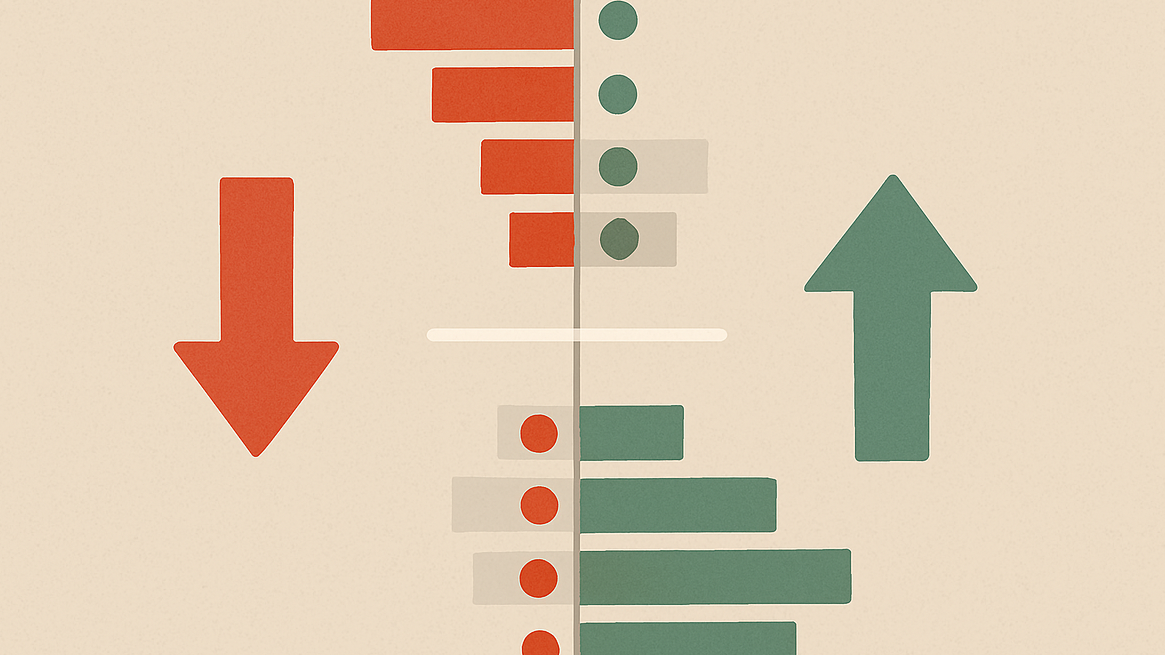Explore how market depth impacts trading efficiency, liquidity, and volatility in thin vs. thick markets, enhancing your trading strategies.
Market depth determines how easily large trades can be executed without significantly impacting prices. Thin markets have low trading activity, wider spreads, and higher volatility, making trades slower and costlier. Thick markets, on the other hand, boast high liquidity, tighter spreads, and stable prices, enabling smooth and efficient order execution.
Key Differences at a Glance:
| Feature | Thin Markets | Thick Markets |
|---|---|---|
| Participants | Few buyers and sellers | Many active traders |
| Price Impact | Large price swings | Minimal market impact |
| Bid-Ask Spread | Wider spreads | Narrower spreads |
| Order Execution | Slower, harder to complete | Fast, efficient |
| Volatility | High price fluctuations | Stable prices |
Thin markets suit experienced traders willing to handle higher risks, while thick markets are ideal for those seeking stability and lower costs. Understanding these dynamics helps traders optimize strategies, manage risks, and control costs based on market conditions.
How Are Market Liquidity and Volatility Related?
1. Trading in Thin Markets
Trading in thin markets comes with its own set of difficulties, mainly due to low trading volumes and fewer participants. For example, in August 2024, reduced institutional activity led to lower liquidity, resulting in sharp price fluctuations. This type of environment makes it harder to execute orders efficiently and manage costs.
Impact on Price Movement and Execution
Thin markets can disrupt both price stability and order execution. Large institutional investors, in particular, struggle with executing big trades. These trades often take longer to complete and can significantly influence prices.
Key Challenges and How to Handle Them
Thin markets are prone to sudden shifts in supply and demand, which can lead to unpredictable price swings, as highlighted by Investopedia. Here are some ways to navigate these challenges:
- Position Sizing: Keep trades smaller to reduce their impact on the market.
- Order Types: Opt for limit orders to control the price at which trades are executed.
- Timing: Avoid trading during periods of low liquidity, like late August.
- Risk Management: Use wider stop-loss orders to account for higher volatility.
These strategies can help traders better manage execution issues, but cost considerations in thin markets also require attention.
Cost Considerations
Trading in thin markets often comes with higher costs due to wider bid-ask spreads. For instance, while currency markets may have spreads as tight as 0.01%, thin market conditions for small-cap stocks can push spreads to 1–2% of the asset’s value. Market makers often widen spreads further during low-liquidity periods to offset added risk, increasing transaction costs for traders.
Volatility Management
Thin markets, with their low trading volumes and limited participants, are especially vulnerable to sharp price movements. Algorithmic trading can amplify these swings, causing even more instability. To manage this, traders should reduce their position sizes and adjust stop-loss levels to handle rapid price changes effectively.
2. Trading in Thick Markets
Thick markets stand out for their high trading volumes and strong liquidity, offering traders better execution and market stability.
Market Efficiency and Execution
With a large number of participants, thick markets provide excellent liquidity, allowing traders to execute sizable orders without significantly affecting prices. For example, IEX achieves 95.5% midpoint volume executions under stable conditions, outperforming Nasdaq at 74.8% and NYSE at 78.9%. These conditions also allow traders to utilize advanced tools for deeper market analysis.
Advanced Order Book Analysis
Thick markets offer traders the opportunity to use detailed order book analysis available through advanced indicators. For instance, a Depth of Market (DOM) indicator provides insights into:
- Resting Orders: Highlighting support and resistance levels indicator
- Volume Distribution: Showing where liquidity is concentrated
- Price Level Activity: Identifying patterns in market behavior
Risk Management Benefits
The stability of thick markets helps traders manage risk more effectively. According to the CFI Team:
"Market depth refers to the ability of the market to sustain a substantially larger order without making an impact on the security's market price".
This stability allows for precise position sizing and the use of tighter stop-loss strategies, giving traders better control over their risk.
Optimizing Volume-Based Strategies
High trading volumes in these markets support the execution of complex strategies. Traders can pinpoint ideal entry and exit points, while institutions can process large orders efficiently. This makes thick markets an ideal environment for strategies that rely on detailed market depth data.
Strengths and Weaknesses of Each Market Type
Knowing how thin and thick markets behave is key to crafting effective trading strategies. Let’s break down the benefits and challenges traders face in each market type.
Comparative Analysis
| Aspect | Thin Markets | Thick Markets |
|---|---|---|
| Trading Volume | Low with fewer participants | High with many participants |
| Price Stability | Prone to sharp price swings | Prices remain relatively stable |
| Bid-Ask Spread | Wide spreads, increasing costs | Tight spreads, often as low as $0.01 |
| Order Execution | Hard to execute large orders | Smooth execution with minimal impact |
| Risk Level | Higher due to volatility | Lower with more predictable movements |
| Liquidity | Limited share availability | Plenty of shares readily available |
Market-Specific Opportunities
Thin markets, while risky, can offer unique opportunities for traders who can handle the volatility. These markets may reward those who adapt quickly to price changes and take advantage of inefficiencies.
On the other hand, thick markets are ideal for traders seeking more predictable conditions. The abundance of liquidity and stable prices make them a go-to for consistent trading.
Risk Management Considerations
In thin markets, managing risk becomes especially critical. Institutions often break down large orders to avoid causing significant market movement. For individual traders, this means carefully planning trade sizes and timing to minimize exposure to sudden price swings.
Trading Strategy Implications
The depth of a market heavily influences trading approaches:
-
Thin Markets:
- Better suited for seasoned traders comfortable with higher risks.
- Require advanced entry and exit strategies to navigate volatility.
- Careful position sizing is essential to avoid excessive market impact.
-
Thick Markets:
- A safer choice for beginners or those with a low risk appetite.
- Offer flexibility for a variety of strategies, thanks to their stability.
- Enable efficient execution of larger trades without disrupting prices.
Market depth directly impacts how traders plan and execute their strategies, making it a critical consideration.
Professional Guidance
Experts often advise newer traders to steer clear of thin markets due to their unpredictable nature and low liquidity. Thick markets, with their stability and easier execution, provide a more forgiving environment for those still learning the ropes. Ultimately, the choice of market should align with your experience level, risk tolerance, and trading objectives.
Conclusion
Grasping market depth is crucial for effective trading. It sheds light on how market conditions influence order execution and price movements. The interaction between market participants, order flow, and price behavior plays a key role in shaping trading outcomes across different environments.
To handle varying market depths, consider these strategies:
Market Analysis
Use order book analysis to track bid-ask spreads and volume accumulation, especially in less liquid markets. This information can help predict price shifts and pinpoint the best entry and exit points.
Position Management
Large institutional trades often take longer to execute. To adapt, size your positions carefully and exercise patience, particularly in low-liquidity markets where trading can be more challenging.
Execution Strategy
In highly liquid markets, take advantage of tighter spreads and stable prices. In less liquid markets, prepare for wider spreads and higher costs during execution.
Technical Tools
Modern trading platforms come equipped with advanced indicators for analyzing order books and visualizing market depth over time. These tools are invaluable for spotting support and resistance levels, managing risk, and timing trades effectively based on live data.






